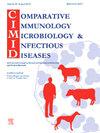埃塞俄比亚阿姆哈拉地区土着种鸡马立克病病毒的血清流行率和危险因素模型
IF 2
3区 农林科学
Q4 IMMUNOLOGY
Comparative Immunology Microbiology and Infectious Diseases
Pub Date : 2025-04-30
DOI:10.1016/j.cimid.2025.102341
引用次数: 0
摘要
本研究旨在评估国产泰利利种鸡及其杂交品种马立克氏病的血清患病率及其发生的潜在危险因素。从2023年11月至2024年6月,在埃塞俄比亚阿姆哈拉地区的7个县进行了横断面血清学研究和问卷调查。采用多阶段抽样方法,从7个区县选取17个农民协会。共抽取768份鸡血清,采用间接酶联免疫吸附试验检测马立克氏病病毒抗体的存在。根据研究,MDV的总体表观血清阳性率为74.6 %,其中安克沙区最低(57.5 %),巴尼亚区最高(93.8 %)。各区患病率差异显著,农会间疾病分布差异有统计学意义。与Tilili品种马立克氏病病毒血清阳性相关的主要危险因素包括与附近其他鸟类接触、性别、年龄组和住房卫生条件。然而,品种、饲养方式、养殖类型等因素与马立克氏病血清状态无显著相关。该病在该生态型鸡中的高血清流行率表明该地区存在活跃的病毒传播,强调需要采取严格的控制措施。在活跃疫情中进一步进行分子研究和鉴定MDV DNA对于确定流行病毒特征和评估该疾病对埃塞俄比亚这些宝贵的土鸡的经济影响至关重要。本文章由计算机程序翻译,如有差异,请以英文原文为准。
Seroprevalence and risk factor modeling of marek’s disease virus in indigenous tilili breed chickens of the Amhara Region, Ethiopia
This study aims to assess the seroprevalence and potential risk factors associated with Mareke’s disease occurrence in indigenous Tilili breed chickens and its crosses. A cross-sectional serological study and questionnaire survey were conducted in seven districts of the Amhara region, Ethiopia, from November 2023 to June 2024. Using multi-stage sampling, 17 Kebeles (peasant associations) were selected from the seven districts. A total of 768 chicken sera were sampled and tested for presence of Mareke’s disease virus antibodies using an indirect enzyme-linked immunosorbant assay test. According to the study, the overall apparent seroprevalence of MDV was 74.6 %, with Ankesha district having the lowest prevalence (57.5 %) and Banja district having the highest (93.8 %).The prevalence varied significantly across the studied districts, and there was a statistically significant variation in disease distribution among the peasant associations. Key risk factors associated with Marek’s disease virus seropositivity in Tilili breeds included contact with other birds in the vicinity, sex, age group, and sanitation of the housing. However, factors such as breed, rearing method, and farming type were not significantly associated with Marek’s disease sero-status. This high seroprevalence of the disease in this chicken ecotype indicates active circulation of the virus in the area, underscoring the need for stringent control measures. Further molecular studies and identification of MDV DNA in active outbreaks is critical to characterize the circulating virus and assess the economic impact of the disease on these valuable indigenous chickens of Ethiopia.
求助全文
通过发布文献求助,成功后即可免费获取论文全文。
去求助
来源期刊
CiteScore
4.60
自引率
0.00%
发文量
102
审稿时长
40 days
期刊介绍:
Comparative Immunology, Microbiology & Infectious Diseases aims to respond to the concept of "One Medicine" and to provide a venue for scientific exchange. Based on the concept of "Comparative Medicine" interdisciplinary cooperation between specialists in human and animal medicine is of mutual interest and benefit. Therefore, there is need to combine the respective interest of physicians, veterinarians and other health professionals for comparative studies relevant to either human or animal medicine .
The journal is open to subjects of common interest related to the immunology, immunopathology, microbiology, parasitology and epidemiology of human and animal infectious diseases, especially zoonotic infections, and animal models of human infectious diseases. The role of environmental factors in disease emergence is emphasized. CIMID is mainly focusing on applied veterinary and human medicine rather than on fundamental experimental research.

 求助内容:
求助内容: 应助结果提醒方式:
应助结果提醒方式:


